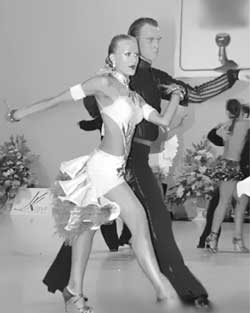
| HOME | MENU | DOCS | SEARCH |
see Recommended reading in dance. Symbols and abbreviations
Incendiary Brazilian dance, part of the Latin American program of sporting ballroom dances. Muses. 2/4 size, rate of 48-52 m / min. (96-104 beats / min).
Alluring, sparkling, energetic, full of vitality samba necessarily associated with Brazil and carnivals in Rio, which is held annually in early February. All of Brazil covered by the continuous thunder of drums beat the rhythm of samba incendiary, immersed in the most bustling, bright and cheerful holiday, a grand show on the planet. The main event of the carnival - the parade of samba schools, where wealth and beauty of melodies mixed with samba dancers luxury costumes and amazing design. They demonstrate different styles of samba; is not only a show, but also the competition with its own rules.

Before samba acquired the current status, it was just a ritual dance of fertility in Africa. In Brazil it was brought Africans slaves. There he merged with the Spanish and Portuguese dances brought from Europe by the conquerors of South America. Mixed dance style aristocracy subsequently adapted for ballroom dancing. Around 1885 he was recognized as Rio high society and popularized under the name «Zemba Queca». Then he was again altered and called Mesemba. In the early twentieth century. Mesemba was combined with another Brazilian dance Maxixe and spread to the US and Europe. Samba in the existing modern form still has figures with different rhythms that explains the origin of multi-faceted dance.
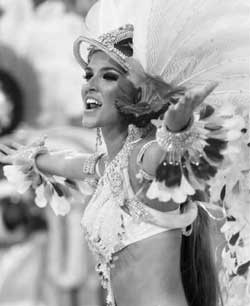
In the 1920s. popularity as samba music has grown to such an extent that it has become run on carnivals and become a favorite style. Over time, when the samba schools, festivals have become a competition in which the best of the best led the crowd into raptures rhythmic dance movements and elaborate costumes. The public is beginning to perceive the samba as a source of national pride, and, finally, the samba was officially recognized, and then spread throughout the world. In 1925, the samba was brought to Europe, where it began to be widely studied and developed.
One of the variants of samba - Carioca - is becoming popular in 1934 after the release of the film "Flight to Rio" with Fred Astaire and Ginger Rogers, and then films with the participation of Carmen Miranda (eg, "That night in Rio de Janeiro").
In 1956, Samba has been standardized English choreographer Pierre Lavelle for international competitive performance.
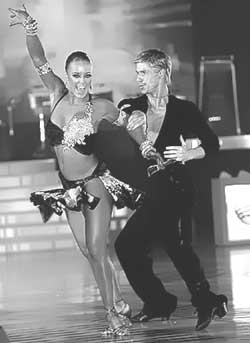
Energetic dance moves, with a light springy step "on the muscles," without sharp ups and downs of different, often syncopated rhythm, with great advancement in the hall.
Samba is incredibly interesting for its ability to absorb almost any South American rhythms, extremely entertaining and dynamic. It is very popular and easily modified to form new dancing (lambada, Makarov et al.) And keeping intact their African origins.
Samba remains the original and multifaceted art. Over time, the music and dance the samba divided into different substyles (Carioca, Baion, Conga, Mesemba, Batucado). In addition, Samba can be lively carnival (Samba carnavalesca), a quiet song (Samba cansao) and even rap Samba (Samba de breque).
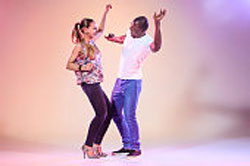
This dance is of Brazilian origin was very popular in its simplified version (two uniform fractions). However, the real dancers prefer his typical rhythm — irregular and intermittent.
Size: 2/4. Temp: 53 106 cycles or beats per minute.
Basic rhythm: the first beat of the bar is equal to three sixteenth and one-sixteenth (account "time-and"). The second beat of the bar is equal to one quarter (two). Consequently, the expense of tact: "time-and", "two". Position: same position as the Rumba, but swaying with your hips to the side and forward and back.
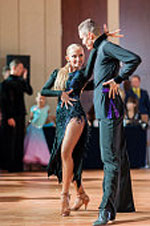
1. The pendulum
The movement is executed on the spot or turn.
For the Partner:
Starts to move the face along the line of dance or against the wall and finishes in the same or any other direction.
1. Step right foot forward (fast).
2. Step left foot forward, almost putting her back to right foot without transferring the weight on it body ("and").
3. Fully transfer body weight to right foot in place (slowly).
4. Step the left leg back (quickly).
5. Step the right leg back, almost having put it to the left, not shifting her body weight ("and").
6. Fully transfer body weight to the left foot in place (slowly).
Repeat with # 1.
For the Lady:
Performs the opposite steps, but first starting with item 4, 5, 6. then 1, 2, 3.
When moving forward the weight of the body is directed slightly backward, while backward movement is slightly forward.
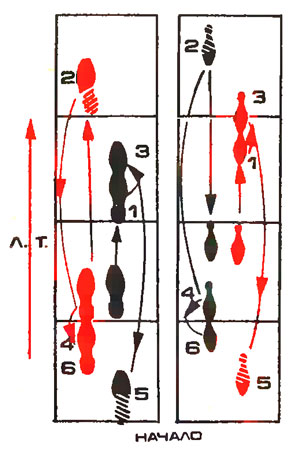
Fig. Pendulum. PA partner and partner
2. Natural basic movement
Begin the movement facing the wall in closed position, feet together, weight on left leg; finish in the same position.
For the Partner:
1. Step right foot forward, at the end of the step to relax the right knee (account "raz").
2. To put or almost put his left foot to the right, straighten knees ("and").
3. To transfer body weight on the right leg, relax your knees ("two").
4. Step the left leg back, at the end of the step to relax the left knee (account "raz").
5. To put or almost put the right foot to the left, straighten knees ("and").
6. To transfer body weight to the left foot, relax your knees ("two").
Repeat as desired.
Springy motion of the knees should be soft and not exaggerated.
For the Lady:
P. 1-3 p. 4-6 correspond to the partner (account "time-and" two"); p. 1-3 p. 4-6 correspond to the partner (account "time-and" "two").
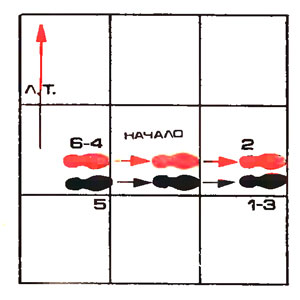
Fig. The main motion to the right. PA partner and partner. 3 and 6, only the movement of body weight
Note: the Main motion be performed on the spot or a right turn. The length of the steps does not matter, however efficient each time to rotate a quarter turn.
3. Reverse basic movement
This movement is identical to the previous one, but starts with his left foot. Can be performed with no turn or a gradual turn to the left. The promotion is absent, in the direction of any.
All steps are performed with the pads of feet on all foot.
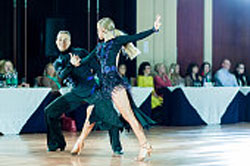
During the formation of Samba as dance of its movement, as in the Rumba was standardized. However, original rhythm is preserved: fast Samba: the account is a "once-and" "two"; slow Samba: slow, quick, quick.
We will consider motions that will allow you to learn the technique some shapes and variations: whisk, Samba in the position of the promenade, adding to that two complex shapes: Boto-Fogo, and court xhaka.
1. Progressive basic movement
Move your face diagonally to the wall in closed position, feet together, weight on left leg; ends in closed position.
For the Partner:
1. Step right foot forward (account "raz").
2. To put or almost put his left foot to the right, partially shifting her body weight ("and").
3. Fully transfer body weight on the right leg, on the spot ("two").
4. Step left foot to side left (account "raz").
5. Pristavit right foot to the left, partially shifting her body weight ("and").
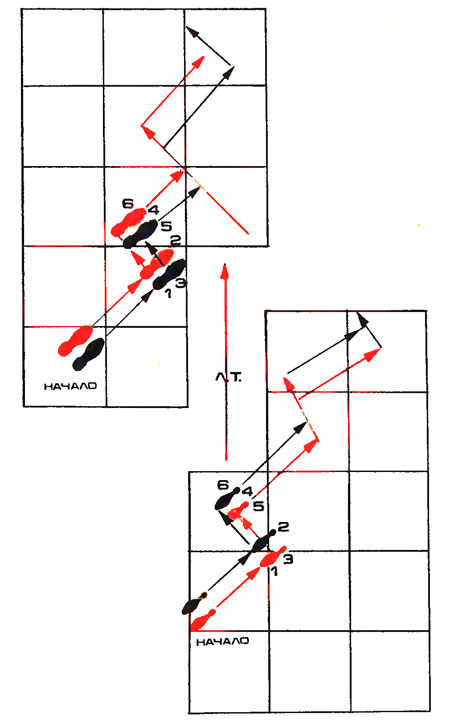
Fig. Progressive basic movement. PA partner and partner
6. To fully transfer the body weight on the left leg, on the spot ("two"). Repeat as desired.
For the Lady:
1. Step the left leg back (account "raz").
2. Pristavit right foot to the left, partially shifting her body weight ("and").
3. To fully transfer the body weight on the left leg, on the spot ("two").
4. Step right foot to side right (account "raz").
5. To fasten the left leg to the right, partially shifting her body weight ("and").
6. Fully transfer body weight on the right leg, on the spot ("two").
2. A course of Samba in line with the partner
Motion begin and end at the line of dance or facing the wall.
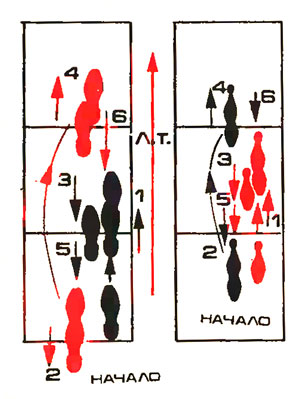
Fig. A course of Samba in a line with a partner. PA partner and partner
For the Partner:
1. A small step (the entire foot) right foot forward, knees relaxed, hips forward, the left foot is at the instep of the right foot (account "raz").
2. To recede the left leg back by a few cm, partially shifting her weight and straightening the knee, hip back ("and").
3. Pull the right foot to the left slightly back, resuming the usual position of the hips ("two").
P. 4, 5, 6 — same, but with the other foot.
For the Lady:
Takes the opposite steps.
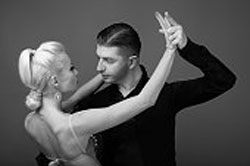
3. Move Samba to the position of the promenade
Start the movement in the position of the promenade to face line of dance, weight on right foot, end up in the position of the promenade line of dance.
In this figure the body motion forward and back focus in the hips. Shoulders stable and are at the same level.
For the Partner:
1. Step left foot forward, hips forward, right knee to relax (account "raz").
2. Step the right leg back with light pressure, partially shifting her body weight, the right knee to straighten slightly ("and").
3. Pull up left foot slightly back to right foot, straightening the knees and hips to return to the normal position ("two").
Repeat with the right leg, then left and right at will.
The hips should not be exaggerated. Knees are relaxed, not straightened.
For the Lady:
1. Step right foot forward, hip forward, the left knee to relax (account "raz").
2. Step the left leg back with light pressure, partially shifting her body weight left knee to straighten ("and").
3. Pull right foot slightly back to left foot, hips to return to its normal position, the knees straighten ("two").
Repeat with the other foot as desired.
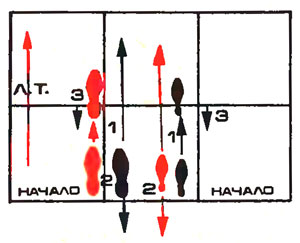
Fig. Move Samba to the position of the promenade. PA partner and partner
4. Visk right and left
Begin the movement facing the wall in closed position, feet together, weight on left leg; ends in closed position.
During the execution of the temple should apply the downward movement — springy motion in her knees, shoulders are at the same level. All the steps with the pads of the foot or the entire foot flat. Partner starts visk right, partner left, stand facing each other. Promotion in this figure is missing.
For the Partner:
1. Step right foot to side right (account "raz").
2. Put your left leg over your right, toe to heel, with the foot turned outward ("and").
3. To transfer body weight on the right leg, on the spot ("two").
4. Step left foot to side left (account "raz").
5. Put right leg behind the left, toe to heel, with the foot turned outward ("and").
6. To transfer body weight on the left leg, on the spot ("two").
Repeat as desired.
For the Lady:
P. 1-3 p. 4-6 correspond to the partner (account "time-and" "two"); p. 1-3 p. 4-6 correspond to the partner (account "time-and" "two").
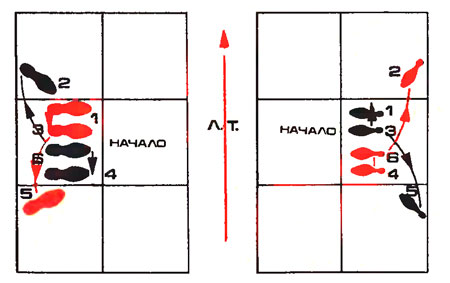
Fig. Samba whisk left and right: a) PA partner; b) PA partner
5. Boto-Fogo promotion
During this variation, the dancers moving down the line of dance, doing a quarter turn to the right and a quarter turn to the left. Experienced dancers turn more feet, and the body left right in front of the partner. Knees slightly relaxed, a small spring-loaded movement of the knees.
For the Partner:
1. Step the right leg forward to the side of the partner on the right side, diagonally to the center, starting to turn to the right (account "raz").
2. A small step left foot to side left paluobiai on it ("and").
3. To transfer body weight on the right leg, on the spot, completing a quarter turn to the right ("two").
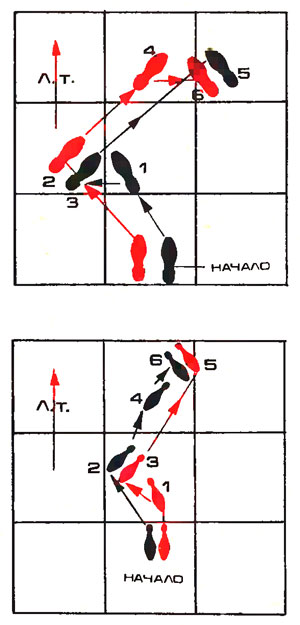
Fig. Boto-Fogo with the promotion. PA partner and partner
4. Step left foot forward on the left side of the lady diagonally to the wall, starting to turn left (account "raz").
5. A small step right foot to side right paluobiai on it ("and").
6. To transfer body weight on the left leg, on the spot, completing a quarter turn to the left ("two").
Repeat as desired.
For the Lady:
1. Step the left leg back, partner on the side with the right side (account "raz").
2. A small step right foot to side right paluobiai on it ("and").
3. To transfer body weight on the left leg, on the spot, completing a quarter turn to the right ("two").
4. Step the right leg back, partner side left side (account "raz").
5. A small step left foot to side left paluobiai on it ("and").
6. To transfer body weight on the right leg, on the spot and completing a quarter turn to the left ("two").
Note: This variation can also be performed by the partner, stepping back. In this case, it is necessary to associate with the movement back and forth. The partner should try to behave your partner, gently pointing her movements of the body, and the wrist of the right hand what direction should be taken prior to execution of the PA.
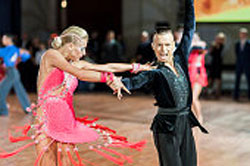
6. Boto-Fogo in shadow position
The shadow position is when the partner and the partner dance side by side in the direction of line of dance (partner slightly ahead). This figure attracts dancers for its unusual position in the pair. In order to take this position, the partner must during the the basic movement to expand the partner to your right hand or, better still, to stop her in the moment when it is face the line of dance. The partner holding the partner's waist with your right hand.
This variation can also be performed after the outer core of the movement for what partner, taking a step back, puts the partner in the position of the promenade. To sing this variation is possible only in the case when the feet of the partner and the partner parallel. Therefore, a partner during the movement of your partner have to miss one step. Thus, they start with the same foot variation, which turns the same.
For the Partner and the Lady:
1. Cross right foot in front of left, weight on right foot (account "raz").
2. Move the sock with your left foot to the left and diagonally forward, partially shifting her weight and beginning a turn to the right (count "and").
3. To transfer body weight on the right leg, slightly pushing it forward and completing a quarter turn to the right ("two").
4. 5. 6. Repeat the movement of # 1-3, but with the other foot (count "one-and", "two").
Repeat as desired.
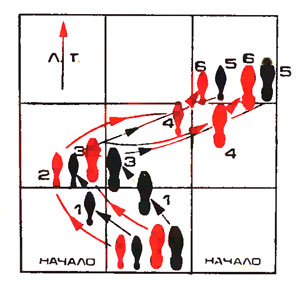
Fig. Boto-Fogo in shadow position. PA partner and partner
Note: to return to the primary motion, partner together with your partner needs to re-execute basic step, then skip one step and performing one or other variation, the legs are the opposite, as usual.

7. Court xhaka
This is a very beautiful variation requires ease of execution and a serious workout. Beginners it is better to avoid it.
For the Partner:
The movement begins in closed position facing the wall, feet together, weight on left leg; ends in closed position.
1. Step right foot forward (slow).
2. A small step with the left foot forward with heel, partially shifting her body weight (quickly).
3. Pull right leg to left leg, keeping her body weight (quickly).
4. A small step the left leg back with toe, partially shifting her body weight (quickly).
5. Pull the right foot to the left, keeping her body weight (quickly).
6.7. Repeat step 2, 3.
For the Lady:
1. Step left foot back (slow).
2. A small step the right leg back with the toe, partially shifting her body weight (quickly).
3. Pull left foot to right foot, keeping her body weight (quickly).
4. A small step the right leg forward with the heel, partially shifting her body weight (quickly).
5. Pull left foot to right foot, keeping her body weight (quickly).
6. 7. Repeat step 2, 3.
Note: the Partner finishes the variation, performing the main motion ago.
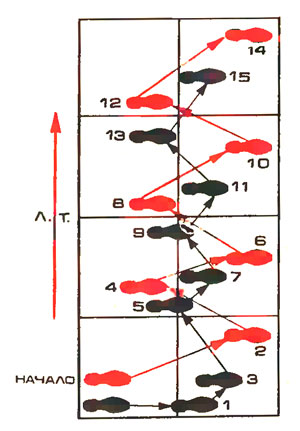
Fig. Court xhaka. PA partner. Partner performs the opposite steps
Chords and variations
1. A course of Samba in line with partner — pendulum — the Samba in a line with a partner — base movement with a right turn. Repeat.
2. The Samba course in line with your partner — whisk to the right, to finish in promenade position — a course of Samba in this position — change of foot partner — Boto-Fogo in shadow position — change of foot partner — lead partner in original position — progressive basic movement. Repeat.
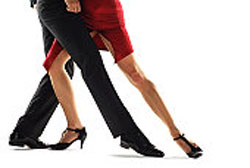
3. The main movement in rotation to the right (3 times) to the position of a face line of dance in promenade position — a course of Samba in the position of the promenade back to its original position, turning to the desired direction — progressive basic movement.
4. Visk left and right, to finish in promenade position along line of dance — move Samba to the position of the promenade take direction face to the wall court xhaka — base movement in the turn to the left until facing the line of dance — Boto-Fogo with the promotion of natural basic movement to a position against the wall, a new direction.
5. Boto-Fogo with the promotion, the partner is in the position of the promenade on the fourth step — a course of Samba in the promenade position, the lady closes the position with support on right leg — basic movement with a right turn to position the face on the new line of dance. Repeat.
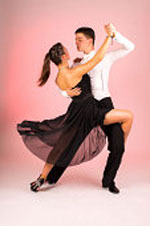
<< Back: Latin ballroom dance program
Maria Vasilevskaya "Dances from A to Z" book about dance for a wide range of readers
We recommend that you look at the popular sections of the site myvaleology.com: MENU with a description of the sections | |||
| SOCIAL | DONATION | MY DIET | MY SPORT |

|
Release all4e8 |
||
Copyright © VZOJ 2023. All rights reserved. When reprinting or quoting myvaleology.com materials please put a link to the site myvaleology.com :
<a href="https://myvaleology.com">Healthy lifestyle</a>